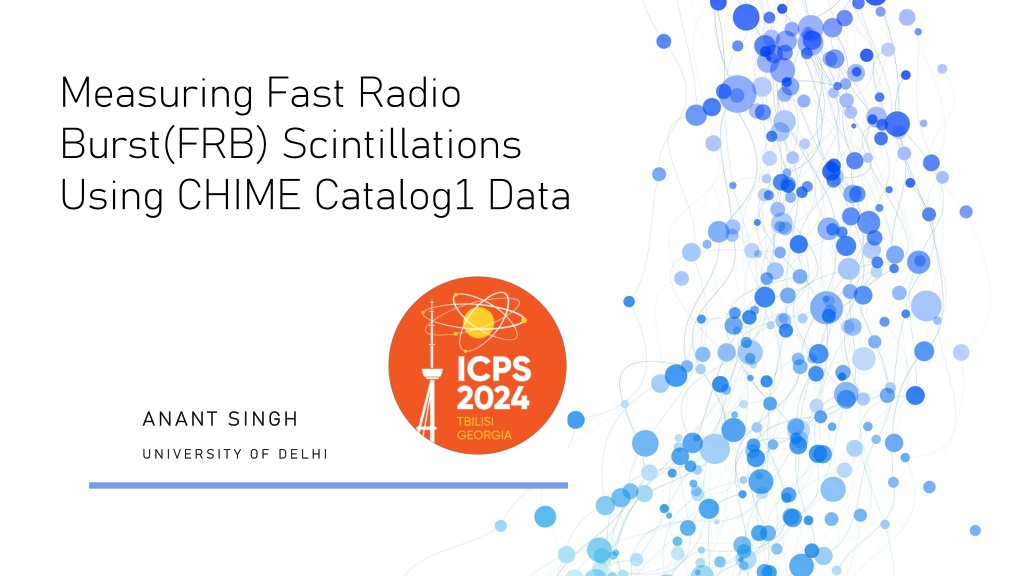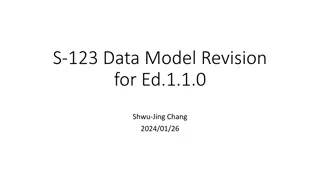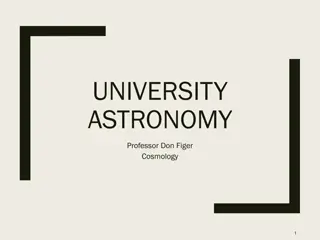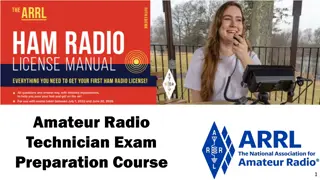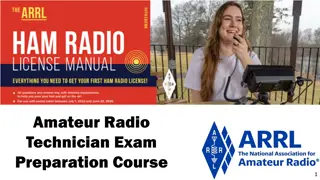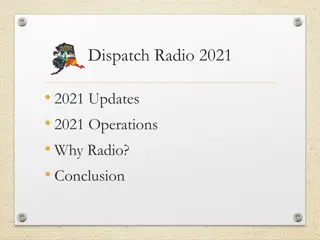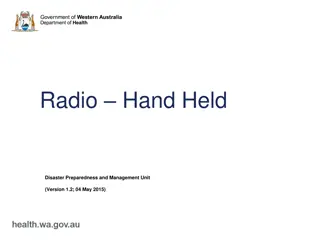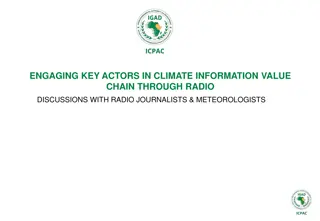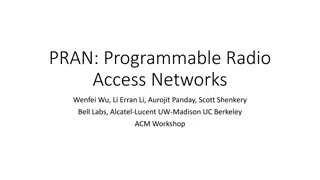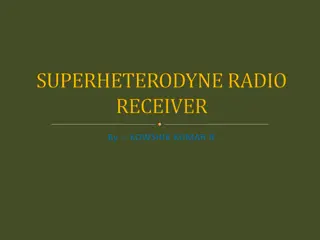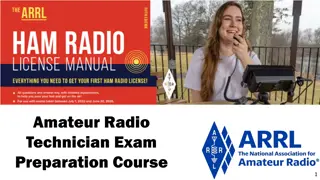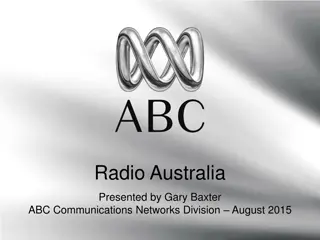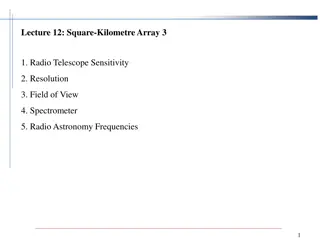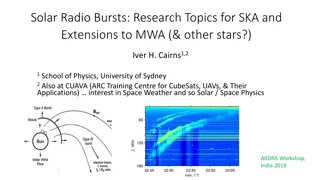Exploring Fast Radio Bursts (FRBs) and Scintillations in the Universe
Fast Radio Bursts (FRBs) are millisecond-duration bursts of radio waves originating from outside our galaxy, offering researchers a unique opportunity to investigate baryon distributions and probe the cold gas clumps in the Universe. Scintillations in radio waves caused by irregularities in the intervening medium between the source and the observer can be studied to gain a deeper understanding of FRBs and their implications. The Dispersion Measure (DM) helps quantify the total column density of free electrons, aiding in inferring the amount of matter the signal has traversed. The CHIME/FRB Telescope is a groundbreaking radio telescope enabling vast sky surveys without moving parts.
Uploaded on Sep 16, 2024 | 1 Views
Download Presentation

Please find below an Image/Link to download the presentation.
The content on the website is provided AS IS for your information and personal use only. It may not be sold, licensed, or shared on other websites without obtaining consent from the author. Download presentation by click this link. If you encounter any issues during the download, it is possible that the publisher has removed the file from their server.
E N D
Presentation Transcript
Measuring Fast Radio Burst(FRB) Scintillations Using CHIME Catalog1 Data ANANT SINGH ANANT SINGH U N I V E R S I T Y O F D E L H I U N I V E R S I T Y O F D E L H I
What are Fast Radio Bursts (FRB)? Fast radio bursts (FRBs originate from outside our galaxy. FRBs) are millisecond-duration bursts of radio waves that mostly Although their origin is still a mystery, studies have hinted at magnetar being a probable explanation. Other theories suspect neutron star-white dwarf mergers as possible cause. Although there are some recent studies showing a preference for the magnetar model, but more study is needed to say anything conclusively.
FRBs as cosmological probe FRBs are provide researchers with a unique opportunity to investigate baryon distributions on a range of scales. The circumgalactic medium (CGM) of galaxies and the intergalactic medium (IGM) are together expected to harbor about 80 % of all baryons in the Universe. Some studies have hinted at the existence of cool and likely dense gas in the IGM of massive galaxies. The short duration of FRBs makes them an excellent tool for probing cold gas clumps. By measuring the scattering tail and studying scintillation of the FRBs, we can gain a deeper understanding of these phenomena and their implications for our understanding of the universe.
What are Scintillations One of the most remarkable properties of these radio waves are their scintillations can be used as a tool to study the intervening medium to study the intervening medium as well as the FRB source scintillations, which FRB source itself. Scintillations in radio waves are a phenomenon caused by irregularities in the intervening medium medium present between the source and the observer, which scatters the wave in different directions, causing the radio pulses from the source to appear to twinkle or shimmer. caused by irregularities in the intervening
Dispersion Measure(DM) It quantifies the total column density of free electrons ??between the source of the burst and the observer, i.e. ?? = 0 When an FRB signal travels through space, it encounters various ionized media, causing lower frequency waves to slow down more than higher frequency waves. ????? This frequency-dependent delay allows astronomers to calculate the DM and infer the amount of matter the signal has traversed.
CHIME/FRB Telescope Canadian Hydrogen Intensity Mapping Experiment(CHIME) is a novel radio telescope that has no moving parts. Contains four 100-meter-long cylindrical reflectors allowing it to survey a vast area of the sky simultaneously. Large instantaneous field of view (~200 square degrees) Broad frequency coverage (400-800 MHz). Unprecedented detection rate: CHIME has discovered hundreds of FRBs, providing a wealth of data for studying these enigmatic phenomena. CHIME can identify and alert astronomers to new FRBs immediately, enabling rapid follow-up observations. Has detected 500+ FRBs till now.
Objectives for this study: Study the CHIME/FRB Catalog1 Data and develop a pipeline to measure the scintillations for some of the brightest FRBs. Comparing the results with the predictions of NE2001 model (a model of the electron density distribution in the galaxy derived mainly from pulsar DM and scintillation/broadening measurements) in the Milky Way and constrain the origin of the scattering of FRBs. This is done to re-verify the results of a similar study by Schoen et. al. bright E. Schoen, C. Leung, K. Masui, D. Michilli, P. Chawla, A. B. Pearlman, K. Shin, A. Stock, and C. Collaboration), Scintillation timescales of frbs detected by chime/frb, Research Notes of the AAS, vol. 5, no. 11, p. 271, 2021.
Wait, what is NE2001 again? A comprehensive model for the Galactic distribution of free electrons. It acts as an initial, smooth spatial representation of the warm ionized component of the interstellar gas, and also provides interstellar scattering and scintillation predictions for both Galactic and extragalactic entities. The model is based on pulsar dispersion measures, scattering measurements, and other observational constraints. It provides estimates of the distance, dispersion measure, scattering measure, emission measure, and angular broadening for any given line of sight in the Galaxy. The model also accounts for the fluctuations in electron density that cause scintillation and pulse broadening effects
Important Points before we move further If an FRB is scattered in the halo of an intervening galaxy, it will experience a large angular broadening and hence no longer appear as a point source when reaching the Milky Way due to which the source can not be scintillated. On the other hand, if the FRB is scattered near the source, the angular broadening will be small and hence can still scintillate. The study of FRB scintillations is still in its early stages, but it is a promising area of research and has already yielded some interesting results.
Example of scintillations The waterfall plot of FRB20180729A from 590MHz to 630MHz. The waterfall plot of FRB20190124C from 590MHz to 630MHz. No scintillation observed Alternating bright-dark spectra in the data indicate the presence of scintillations
Methodology We downloaded the FRB data from CHIME/FRB Catalog1 database and produced waterfall plots containing the time series spectrum data for the FRBs. This helped us to get a visual look into the burst and get familiar with its spectrum, RFI (Radio-Frequency Interference) masking, SNR value calculations, time series plot and spectrum plot. We plotted the waterfall plots and the SNR values of all the 536 FRBs available on the CHIME/FRB Catalog1 The waterfall plot of FRB20180725A. Waterfall plots are used to show how the recorded data(frequency in our example) is changing over time and it helps to visualize the data from the bursts
Methodology We then selected the 50 brightest bursts, i.e., having the highest signal to noise ratio (SNR value) from the dataset and filter the data using the RFI masking and renormalize it. Then we fit a cubic spline to our data which will give us a smoothed spectrum. The spline has knots separated by 7MHz. The knot separation is chosen so the noise from system temperature in the data could be eliminated while preserving the significantly smaller scintillation structures.
Methodology In our study, scintillation bandwidths are almost all below 2MHz. We divide our data with this fitted spline and the result is a new set of spectrum values that have been adjusted based on the smoothed function, which we may refer as smoothed spectrum spectrum. smoothed We slice our smoothed spectrum data into smaller sub-bands. This will help to analyze specific portions of the data in more detail and look into the scintillations present in that sub- band. The choice of sub-band was carried out by the following method: 0.189 Putting = 400, we get a sub-band limit of around 75MHz or less. In our study, we chose 40MHz sub-bands from this data from the regions across the full 400- 800MHz frequency range where the noise is not way too large as compared to the data.
Methodology We calculate the Autocorrelation Function for each of the 40MHz sub-bands of the smoothed spectrum data. Autocorrelation for discrete data sets is calculated as: Auto correlation is used to show how the data points are related with their own time- delayed version. We plot them for the positive time-lags, in which a peak region in the plot signifies the data being correlated with itself in/near that region. The renormalized autocorrelation plot of a portion of spectrum data of FRB20180729A, the subband from 600MHz to 630MHz
Methodology We find the best fit parameters for _dc - the decorrelation bandwidth, i.e. the frequency range over which the data becomes decorrelated; and m - the modulation index whose value depends on how bright/dark a scintle is ranging from 0 to 1. We use the model: The fitted parameter plot will then be plotted against the autocorrelation plots for each sub-band of an FRB. We can notice a steep rise in the start and then the curve flattens out, suggesting the presence of scintillation. The width of the rise in the auto-correlation function plot tells us the de-correlation bandwidth( _dc) of the scintillation.
Methodology The fitted value of _dc is then plotted against the frequency, as it is expected to follow a frequency-dependent power law, given by: The data points should be well within the power-law curve.
Methodology We now calculate the scintillation time scale using _dc by using the formula. We use assume C_1 = 1 for the ISM in the Milky Way. This obtained timescale is then compared with the predicted timescales from the NE2001 model. Scintillation timescale is the characteristic time over which the intensity of a scintillating object fluctuates. The study of scintillation timescales be used to learn about the properties of the scattering medium, such as its density and velocity
Results An example: An example: The plot of autocorrelation of spectrum data against frequency lags for each sub-band of FRB20190124C
Results Plot for the frequency dependence of the decorrelation bandwidths. As can be seen, the data seems to agree with the power curve.
Results The empirical distribution of scintillation timescales compared to NE2001 predictions at 600MHz. The gray line is the y = x line. The green dot represents the FRB20190124C. As can be seen, almost all the FRBs are in agreement with the NE2001 predictions for electron density distributions in the line of sight.
Conclusion We developed a pipeline to measure the scintillation timescales of FRBs Pipeline was then used to analyze the 50 brightest FRBs for our study. From results, we can infer that for a large fraction of FRBs, the ISM in the Milky Way contributes contributes to short short scattering timescales. scattering timescales.
Future Works Enhancing our input data using advanced filtering algorithms to remove noise while preserving important information. This will lead to better quality data and improved results. Expand our pipeline to include more FRBs, including those with lower SNR values than the ones studied here. This will allow us to test our pipeline on a wider range of data and make it more robust. Comparing the various theoretical cold gas clump models using the scintillation timescales data obtained from our study.
References M. Amiri, B. C. Andersen, K. Bandura, S. Berger, M. Bhardwaj, M. M. Boyce, P. Boyle, C. Brar, D. Breitman, T. Cassanelli, et al., The first chime/frb fast radio burst catalog, The Astrophysical Journal Supplement Series, vol. 257, no. 2, p. 59, 2021. J. M. Cordes and S. Chatterjee, Fast radio bursts: an extragalactic enigma, Annual Review of Astronomy and Astrophysics, vol. 57, pp. 417 465, 2019. Smith, F.G., Hewish, A. and Scheuer, P.A.G., 1968. Amplitude Variations in Pulsed Radio Sources. Pulsating Stars: A NATURE Reprint, pp.86-88. E. Schoen, C. Leung, K. Masui, D. Michilli, P. Chawla, A. B. Pearlman, K. Shin, A. Stock, and C. Collaboration), Scintillation timescales of bright frbs detected by chime/frb, Research Notes of the AAS, vol. 5, no. 11, p. 271, 2021.
Acknowledgements: California Institute of Technology (Caltech): SURF Program California Institute of Technology (Caltech): SURF Program Cahill Center for Astronomy and Astrophysics Cahill Center for Astronomy and Astrophysics Prof. (Dr.) E. Sterl Phinney Dr. Dongzi Li CHIME/FRB Collaboration CHIME/FRB Collaboration
Interesting Side-note The DM and redshift(z) of an FRB can be used to constrain the values of Hubble constant(?0), baryonic matter density( ?), matter density( ?). This method is currently very good for z>>3 and DM >> 100 pc/cm^3 This is actually a current study I am a part of, which seeks to resolve the Hubble tension. This is just to demonstrate why YOU should be excited about the FRBs, the many exciting properties FRBs might have as a cosmological tool to study and better understand the structure of our SpaceTime!
